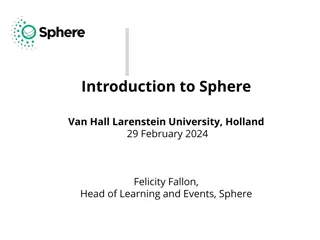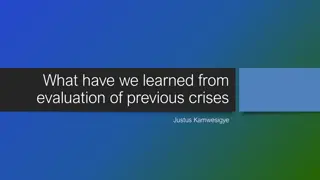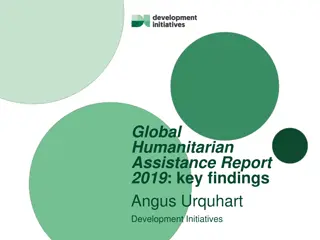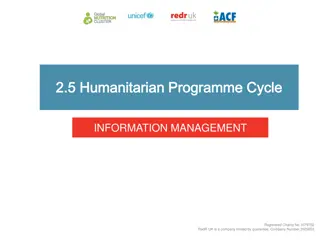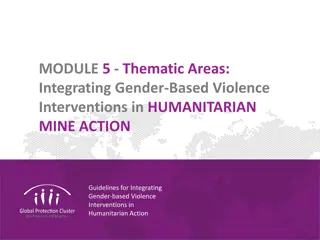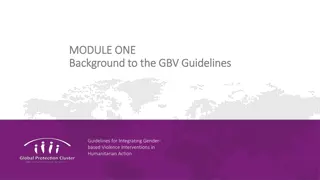Understanding Humanitarian Landscape and Coordination Challenges
The humanitarian landscape involves various organizations working together to provide assistance during crises. Coordination challenges, such as identifying needs, existing assistance, and government involvement, have been prevalent. The Inter-Agency Standing Committee (IASC) was established in 1991 to improve collaboration among relief agencies. Humanitarian reform in 2005 aimed to address gaps like erratic coordination and inadequate accountability, emphasizing response predictability, leadership, capacity, and financing partnerships. The cluster system plays a crucial role in setting standards, building response capacity, and advocating for resources in global crises.
Download Presentation

Please find below an Image/Link to download the presentation.
The content on the website is provided AS IS for your information and personal use only. It may not be sold, licensed, or shared on other websites without obtaining consent from the author. Download presentation by click this link. If you encounter any issues during the download, it is possible that the publisher has removed the file from their server.
E N D
Presentation Transcript
1.2 The Humanitarian Landscape 1.2 The Humanitarian Landscape INFORMATION MANAGEMENT Registered Charity No 1079752 RedR UK is a company limited by guarantee. Company Number 3929653
Coordination challenges in the early 2000s What Who needs assistance? organisations are already here? Is anyone already doing X? Where can I get information? Who is doing Y in X-town? What is the government doing ? Who is in charge? Where do people need assistance? How can I get funds?
What is the IASC? The Inter-Agency Standing Committee (IASC) = Global humanitarian forum established in 1991 by a UN GA resolution to bring together the main operational relief agencies from the United Nations, the Red Cross/Red Crescent Movement, the IOM and international NGOs.
Why was Humanitarian Reform (2005) needed? 200371818 20053224 Well-known, long-standing gaps Unpredictable capacity Ad-hoc responses Erratic coordination, weak partnerships Insufficient accountability among humanitarian agencies Donor policies inconsistent
Humanitarian Reform STRENGTHENING HUMANITARIAN RESPONSE PREDICTABAILITY LEADERSHIP CAPACITY & FINANCING PARTNERSHIPS
Responsibilities of global clusters Normative Standard setting and consolidation of best practice Build response capacity Training and system development at local, regional and international levels Surge capacity and standby rosters Material stockpiles Operational Support Emergency preparedness Advocacy and resource mobilisation
2 0 1 0 2 0 1 0 Floods in Floods in Pakistan Pakistan Earthquakes Earthquakes In Haiti In Haiti UN Photo/Evan Schneider UN Photo/Logan Abassi
Roster of Emergency Coordinators for Level 3 Emergencies Empowered Leadership for staff (women and men) and affected people with specific needs, women, girls, boys and men. Inter-Agency Rapid Response Mechanism (IARRM) Leadership Training
Strategic Use of Clusters Simplified Cluster Management Minimum Commitments for Participation in Clusters Strengthening NGO (women s rights organization, in particular) Representation in the Humanitarian Country Team
Common Humanitarian Programme Cycle (HPC) to achieve collective results Cross-cutting issues are addressed and incorporated in AAP and HPC for an effective nutrition programming in emergencies (e.g. gender, GBV, empowerment, environment etc.) Assessment, Strategic Statement, Resource Allocation, Implementation, Monitoring, Reporting and Evaluation Common Performance and Reporting Framework including gender and GBV protection performance Accountability to Affected People (AAP) using a gender and GBV inclusive approach (e.g. survivor centered, community based and human rights approaches)
Six Core Functions of Clusters 1. Support service delivery 5. Build national capacity in preparedness and contingency planning 2. Inform the HC/HCT's strategic decision-making 6. Advocacy + Accountability to affected population (AAP) 3. Plan and implement cluster strategies 4. Monitor and evaluate performance
Level 3 Emergencies declared by IASC to be exceptional in: Complexity Scale Urgency Reputational Risk Capacity
Exercise: Building the HPC 5 minutes to put together the stages of the HPC on Flipchart You may be asked to explain the logic behind your cycle.
Humanitarian Programme Cycle The phases are inter-related and should be managed in a seamless manner using a coherent approach and a common set of tools.
Typhoon Haiyan Philippines 2013 You are here Ebola epidemic Sierra Leone, Liberia, Guinea 2013-2015 Syrian Refugees in Amman, Jordan, 2011-present Conflict IDP and food security crisis South Sudan 2013-present Sahel Food insecurity 2011-present
In your assigned scenario Who are the main actors in responding to the humanitarian situation and what impact does the context have on information management?
Humanitarian Actors National Government HCT HC Humanitarian Response OCHA Other Clusters Cluster Lead Agency Nutrition Cluster UN NC- CT Global Nutrition Cluster Agencies NGOs Observers
National Government Has primary responsibility for safety, security and well being of own citizens Responsibility for protection of displace people and refugees (particularly women, girls and children) within its borders Responsibility for safety and security of humanitarian workers and other expatriates from the risks of any sort of violence and harassment Is responsible for maintaining law and order and legal aid support Has control of admission to the country Is responsible for facilitating coordination between the agencies and partners






